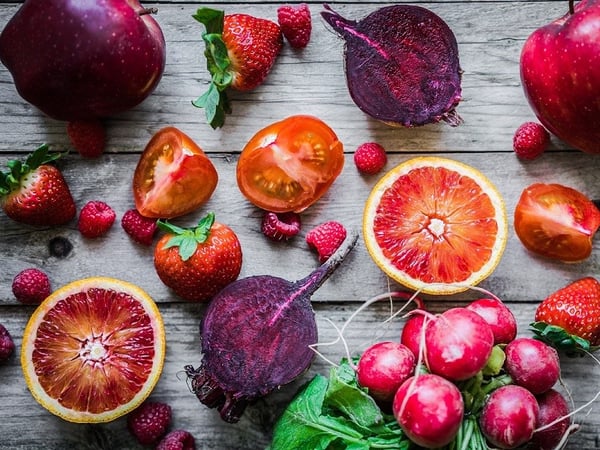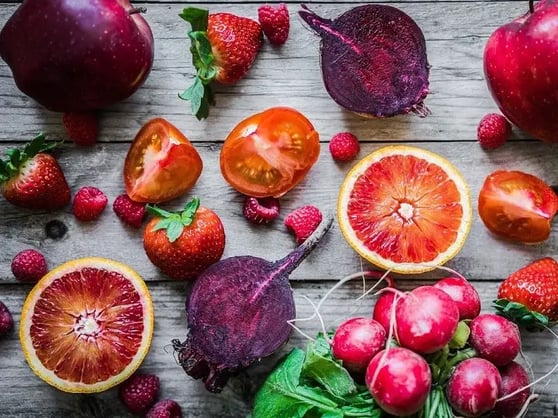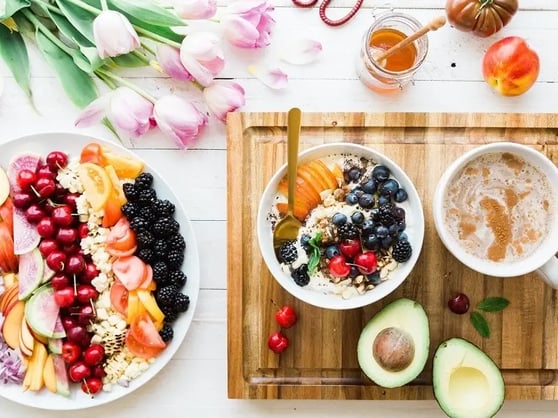10 healthy foods to include in your diet

A healthy diet is integral to good health, no matter what your age is. While specialised diets like the Whole30 or Paleo diet have become increasingly popular in recent years, there isn't a distinct need for you to undertake something as specific in order to eat more healthily. Such specialised diets are more suitable for people with certain food allergies or who are on a specific weight-loss plan. The guide to eating healthily is as simple as picking the right foods and eating in the right amounts and proportions.

Photo: Active Health
What healthy eating is all about
Maintaining a healthy diet isn't only about eating healthy food; it's also about eating a healthy amount of food. Overeating often leads to weight gain and can cause obesity-related issues in the long run. If you constantly consume more calories than the amount your body requires based on your age and activity levels, you may experience weight gain even if you are only eating healthy food. This is why the starting point of a healthy diet is always about ensuring you are eating the right portion sizes for your health requirements.
It can be difficult to figure out how much food you need, so it's a good idea to get some professional help from nutritionists - you can get useful information from our Active Health Labs! Another important thing to note is to ensure that you are eating in the right proportions. That is, eating balanced amounts of food from the different macronutrient groups such as carbohydrates, protein and fat.
Eating in the right proportions
The general rule for a balanced diet is 50% fruits and vegetables, 25% whole-grain carbohydrates and 25% meat and others. This is based on the Health Promotion Board's My Healthy Plate campaign and the guideline is pretty easy to follow if you cook at home.
"We advocate meeting recommendations of consuming 2 serves of fruits and 2 serves of vegetables a day as the overall nutritional quality of the diet matters more," says Cheryl Teo, Sport Dietitian at the Singapore Sport Institute.
She added: "Select fruit and vegetables from a variety of colours as each colour represents different vitamins, minerals, antioxidants and phytochemicals content."
To that end, here's a list of the top 10 healthy foods from across various food groups.
 Photo: Active Health
Photo: Active Health
The top 10 healthy foods
1. Salmon
Food group: Protein/Meat
Salmon is definitely one of the healthiest meats - it contains lots of nutrients like omega-3 fatty acids, B vitamins and magnesium, and it also helps with weight loss by promoting satiety. The nutrients mentioned are essential for maintaining healthy body functions, especially omega-3 fatty acids, which regulates blood pressure and reduces the risk of heart diseases. Plus, salmon is delicious and there are many healthy ways to cook the meat without using too much oil such as grilling, broiling, poaching or oven-roasting it. ]While this fishy friend of ours is definitely a great choice of meat because of its nutritional benefits, excess consumption of omega-3 fatty acids can have a negative impact so limit your salmon consumption to once or twice a week.
2. Milk
Food group: Protein/Dairy
Growing up, practically of us have tasted milk at one point or another. Aside from the bone-boosting calcium, milk also contains a host of other important nutrients such as protein, potassium, phosphorus and vitamin B12. Certain brands of cow's milk is also fortified with additional vitamin D, and grass-fed, full-fat dairy sports vitamin K2. Milk's mainstream status means that practically anyone can enjoy its benefits: there's lactose-free variants for those who happen to be intolerant, and goat's milk is a popular alternative for individuals whose digestive system is sensitive to cow's milk.
3. Shellfish
Food group: Protein/Meat
Shellfish are rarely a common feature in our diets, but they should be. Food such as scallops, clams, mussels and oysters are excellent sources of vitamin B12 which helps to regulate red blood cell production. Do be careful when eating shellfish though - make sure the meat is well cooked because raw or undercooked shellfish can cause a vibriosis infection.
4. Egg yolk
Food group: Protein
Eggs are common foods in most Singaporean diets, and they have good reason to be. Despite the health concerns raised about their high cholesterol content, eggs provide lots of healthy vitamins and minerals when consumed in moderate amounts. Furthermore, eggs are a huge source of protein and healthy fats. Where possible, opt for whole eggs as these are healthier and more nutritionally complete.
5. Kale
Food group: Vegetables
Kale is one of the best leafy green vegetables for your health as it is abundant in vitamins C, A, K1 and B6, as well as dietary fibre, minerals and anti-oxidants. Vitamin C is great for immune system health while vitamin A combats inflammation. Most leafy vegetables are already rich in these vitamins, but what makes kale more nutritious is the fact that it is great for bone health. The calcium in kale helps to maintain strong bones while vitamin K1 prevents this calcium from being deposited in the arteries, hence allowing the minerals to be absorbed better.
 Photo: Active Health
Photo: Active Health
? JOIN US: Island-wide experiential Eat Better workshops led by Active Health Coaches
6. Seaweed
Food group: Vegetables
We all love our crispy seaweed snacks, but there's more reason to indulge in seaweed than just the taste. Seaweed is a type of vegetable that grows in the ocean rather than on the land so it is able to absorb minerals from the seawater directly. This makes seaweed even richer in nutrients than farm vegetables, especially when it comes to minerals like calcium, iron, magnesium and iodine. Iodine is essential for the healthy function of thyroid hormones which helps to manage growth, heal damaged cells and regulate our metabolism.
7. Garlic
Food group: Vegetables
Garlic is an indispensable ingredient in the kitchen because of its ability to spice up any dish, but this root vegetable also happens to be very good for health. Root vegetables are generally very nutrient-rich because they absorb minerals directly from the soil. Garlic happens to be a big source of vitamin C, B1 and B6 as well as other minerals. The sulphur in garlic also helps to regulate blood pressure and cholesterol levels, which makes it an important dietary component in the fight against heart disease. Besides being good for our physical health, garlic can do wonders for our mental health too. Garlic is known to have a calming effect because of its high concentration of stress-alleviating anti-oxidants.
8. Potatoes
Food group: Carbohydrates
Potatoes are a staple food in many European fares due to their filling nature. Apart from that, potatoes are also high in vitamin C, B vitamins and a wide variety of other minerals. Nevertheless, the way potatoes are cooked affects their health benefits. Potato chips and french fries are some of the best-loved snacks but they can be extremely unhealthy due to the high amounts of salt and oil used in their preparation. On the other hand, boiling or steaming your potatoes is one of the healthiest and simplest ways to cook them. Leaving them to cool after cooking allows them to form resistant starch, which makes them better for digestion and reduces their impact on your blood sugar levels.
9. Blueberries
Food group: Fruits
Almost all fruits are good for health in some way, but blueberries are especially high in nutrients. Blueberries are particularly great for boosting brain health - some scientific studies have found that blueberry improves memory! This blue wonder also fights obesity by regulating blood pressure and cholesterol levels.
10. Dark chocolate
Food group: Others
Desserts tend to fare poorly in the health department, but dark chocolate is a notable exception. The cocoa in dark chocolate is full of health benefits, especially because of the high concentration of anti-oxidants which help to regulate blood flow and blood pressure - this gives dark chocolate the ability to fight heart disease. Dark chocolate is so good for your health that you can eat it every day. One small square of chocolate a day will boost your health significantly. When selecting your treat, look for one that contains a minimum of 70% coca solids to experience the legitimate benefits of dark chocolate.
 Photo: Active Health
Photo: Active Health
Choosing healthy foods
Apart from knowing what foods are healthier, it is also important to select the right variety when shopping in the supermarket. Here are some ways to help you select the right kinds of healthy food.
> Check the ingredients list
The ingredients list will tell you all you need to know about the product. Since ingredients are listed in order of percentage of content, it can help you to create a more accurate profile of the product in question. The length of the list matters too. Natural foods that don't contain lots of additives are better, so avoid foods with long ingredient lists. Additionally, look out for fibre content and sugar levels rather than focusing on calories alone. Prioritise fibre and avoid excessive sugar, especially refined sugar.
> Go for 100% whole grain
When it comes to carbohydrates, 100% whole grain selections are much better for health. Anything that isn't indicated as such is probably processed with refined grains, which don't offer nearly the same kind of nutritional benefits as whole grains.
> Choose fresh over processed food
The basic supermarket rule is to avoid foods in the aisles and to go for foods outside of them because the aisle shelves tend to contain more processed foods that are laden with added sugars and other preservatives. Fresh food offers a more complete nutrient profile and gives you full control over their method of cooking.
> Know your fat
The dietary fat that comes with animal meat (e.g. salmon) isn't something to be feared. Monounsaturated, polyunsaturated and saturated fat all play a part in supporting good health when consumed appropriately. Even naturally-occurring trans fat (such as those found in cheese) can be safe in moderate amounts. The danger to look out for is a skewed fat profile ratio. Vegetable oils like sunflower oil tend to offer an excessive amount of polyunsaturated fat, which can lead to the formation of free radicals and cellular damage when consumed due to their ease of oxidisation. Due to the already high presence of polyunsaturated fat in modern diets, a better choice of cooking fat would be those that offer less in the way of that, such as coconut oil, avocado oil, extra-virgin olive oil, macadamia oil, butter and ghee.
Tips on making delicious healthy food
> Spice it up
Beyond your typical salt and pepper lies a wide variety of spices that you can use to bring the flavour of your dishes to a whole other level. Cinnamon, cumin and paprika should be treated as kitchen staples due to their synergy with various foods. Mixing certain spices together (e.g. turmeric with black peppercorn) can even boost their individual properties for greater health benefits. You can even use spices to take your standard meal in an entirely different direction - one dish with two distinct flavours!
> Play with herbs
Like spices, herbs are an indispensable part of healthy cooking. Parsley, basil, oregano and thyme convey textures that most of us are already familiar with when it comes to dining outside, so its inclusion in home cooking shouldn't be too off-putting. Herbs play very well with spices and can be used to either elevate flavours or add a different dimension to them. For certain strong-smelling dishes (e.g. those that use organ meat), herbs can be a good way to mask what would otherwise be an overpowering aroma.
> Go nuts
Tree nuts like almonds and cashews make for good, nutrient-dense snacks. Their portability makes them a good choice for when you're on the go, but there's more to enjoying nuts than just popping them whole. Chopped nuts make for excellent and flavourful toppings for salads and yoghurt. You can even make a mix of them with a herb/spice blend, add a light coat of oil, and bake them to create a truly spectacular side dish. The next time you do up a batch of your favourite basmati rice, try preparing it with cashews, green peas and coriander for a less boring staple!
Learn to use food labels
The labels that are printed on the back of food products can give us a better understanding of how they'll impact our bodies. Combined with ingredient lists, food labels can effectively tell us if a product is worth purchasing or if it's better to move along. A typical breakdown includes your three primary macronutrients (carbohydrates, protein, fat) along with other minerals such as sodium.
?READ: Healthy eating playbook - cracking the food label
Food labels aren't fixed and different product types will feature different readouts. Some will include a panel on vitamin content while others will mention cholesterol. The key to making full use of food labels is to first understand YOURSELF. Knowing where your body is at and what it needs is the first step towards determining if the information presented by the food label is relevant. Certain labels will also make a distinction between certain macronutrient sub-types (e.g. sugar and dietary fibre, monounsaturated and polyunsaturated fat), so be sure to study it thoroughly before coming to a decision.

Photo: Active Health
Creating a healthy diet must be a holistic process that includes choosing the right food and regulating portion sizes. The way you cook your food matters too, so it's time to start looking for healthier recipes in order to reap the full benefits from your stash of wholesome food! If you happen to eat out, just opt for food choices that are simpler in terms of preparation (e.g. baked, poached, etc.) Err on the side of caution and you should do just fine!





![ActiveSG Academies and Clubs Logo (Solid Colour)[8647]](https://www.activesgcircle.gov.sg/hs-fs/hubfs/ActiveSG%20Circle%202023Theme/images/ActiveSG%20Academies%20and%20Clubs%20Logo%20(Solid%20Colour)%5B8647%5D.png?width=150&height=65&name=ActiveSG%20Academies%20and%20Clubs%20Logo%20(Solid%20Colour)%5B8647%5D.png)




-01.png?width=200&height=141&name=Team%20Singapore%20Logo%20(Red)-01.png)






.webp?width=120&height=120&name=Seniors%20Sports%20Day%2c%20Photo%20Credit%20-%20Sport%20Singapore%20(5).webp)



